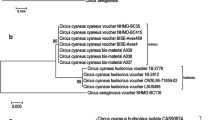Abstract.
Mitochondrial cytochrome b (cyt b) from 25 out of 31 extant goldfinches, siskins, greenfinches and redpolls (genus Carduelis) has been sequenced from living samples taken around the world, specimens have also been photographed. Phylogenetic analysis consistently gave the same groups of birds, and this grouping was generally related to geographical proximity. It has been supposed that Pleistocene glaciations played a crucial role in the origin of extant diversity and distribution of Northern Hemisphere vertebrates. Molecular comparison of most extant songbird species belonging to the genus Carduelis does not support this assertion. The fossil record of chicken and pheasant divergence time has been used to calibrate the molecular clock; cyt b DNA dendrograms suggest that speciation in Carduelinae birds occurred during the Miocene and Pliocene Epochs (9 – 2 million years ago) in both the Northern and Southern Hemispheres. Only about 4% average amount of nucleotide substitution per lineage is found between the most distant Carduelis species; this suggests a remarkably rapid radiation when compared with the radiation of other passerine songbird genera. In addition, a continuum of small songbird speciation may be found during the Miocene Epoch in parallel with speciation of other orders (i.e. Galliformes, chicken/pheasant). Pleistocene glaciations may have been important in subspeciation (i.e. Eastern European grey-headed goldfinches/Western European black-headed goldfinches) and also in ice-induced vicariance (isolation) (i.e. siskin in Western Europe vs. siskin in Far East Asia) around the world. European isolated Serinus citrinella (citril finch) is not a canary, but a true goldfinch. South American siskins have quickly radiated in the last 4 million years coinciding with the emergence of the Isthmus of Panama; probably, a North American siskin related to C. notata invaded a suitable and varied biotope (the South American island) for Carduelis birds. North American goldfinches may be renamed as siskins, because they have a distant genetic relationship with European goldfinches. Genus Acanthis could be dropped, and thus redpolls should be separated from twite and linnet, the latter (Europeans) probably being related to American goldfinches. Also, reproductive barriers are observed between closely related species and not between other more distant ones. Finally, a tentative classification for genus Carduelis species is suggested.
Similar content being viewed by others
Author information
Authors and Affiliations
Additional information
Received 6 March 1998; received after revision 3 July 1998; accepted 7 July 1998
Rights and permissions
About this article
Cite this article
Arnaiz-Villena, A., Álvarez-Tejado, M., Ruíz-del-Valle, V. et al. Phylogeny and rapid Northern and Southern Hemisphere speciation of goldfinches during the Miocene and Pliocene Epochs. CMLS, Cell. Mol. Life Sci. 54, 1031–1041 (1998). https://doi.org/10.1007/s000180050230
Published:
Issue Date:
DOI: https://doi.org/10.1007/s000180050230





